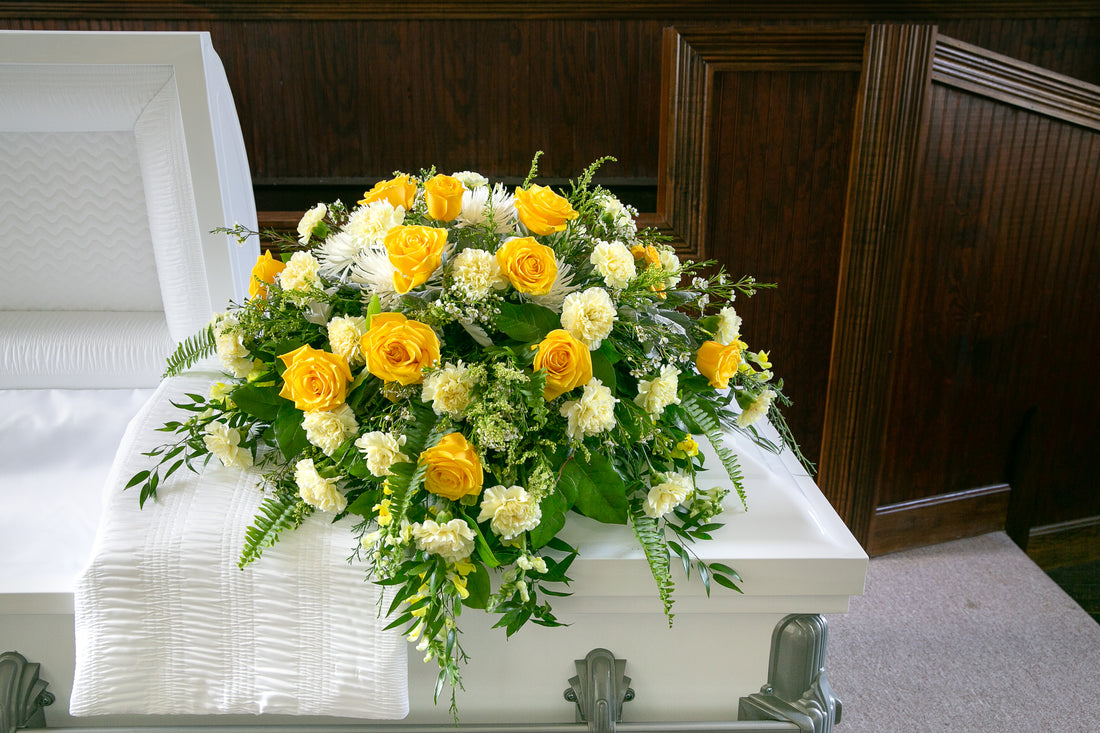While everyone loves seeing beautiful flowers at happy celebrations, they have their place at more somber events, too. Flowers play a vital role at funerals, memorial services, viewings, graveside services, and celebrations of life. People use flowers to honor the deceased, express sympathy to surviving loved ones, and decorate funeral venues.
As a florist, you should use care and sensitivity when crafting funeral flower arrangements and sympathy flowers. In many ways, you can follow your usual process with a few key considerations. Follow this guide to learn more about the different types of flower arrangements required for funerals and what to know about making them.
Common Funeral and Sympathy Floral Arrangements

Flower pillows and wreaths are popular funeral tribute arrangements.
Sympathy floral arrangements generally fall into two categories: tribute flowers and decorations. Funeral tribute flowers may adorn the casket, be laid at the gravesite, or be displayed during funeral services. Those planning the funeral may order tribute flowers, or acquaintances send them in memory of the deceased and sympathy for the surviving family. Decorative flowers are ordered during the funeral arrangements to decorate the funeral home, church, or other venue during the viewing and service.
Many families may ask for custom arrangements that have special meaning to them. But in general, funeral and sympathy floral arrangements appear in the following forms:
- Casket sprays are designed to lay on the casket as a tribute to the deceased. They come in many sizes and designs but are generally shaped to lay flat. A Christian family may request a floral cross to lay on the casket.
- Shaped tributes are floral arrangements shaped like a heart, the deceased person’s initials, or words like “Mom” or “Papa.” They add a lovely personal touch to funeral events and may go on the casket or be displayed on an easel.
- Funeral sheaves are small tied flower bouquets designed to lay flat so attendees can place them next to the coffin or grave to show sympathy and respect.
- Wreaths are popular flower tributes acquaintances send to remember the deceased and offer sympathy to the grieving family. They may be circular, heart-shaped, or another attractive shape. Wreaths are typically displayed on easels.
- Funeral posies are small, round floral tributes sent by friends or acquaintances.
- Floral pillows and cushions are traditional tributes that symbolize comfort and final rest.
- Arrangements in vases or baskets make for lovely sympathy tributes sent by those wishing to express condolences. They may also be ordered to adorn a viewing or funeral service venue and give the occasion its due formality.
- Floral swags and garlands may also make an appearance as decor at funerals.
How does Sympathy Floral Design Differ from Other Floral Designs?

Create funeral flower arrangements with care and consideration for the occasion and how they will be used.
You can use many of the same methods and supplies for creating sympathy flower arrangements as you do for other arrangements. Your goal is to make something beautiful, but that doesn’t detract from the gravity of the funeral events. This isn’t the time to create something avant-garde or ostentatious. Traditional, simple, elegant arrangements are tasteful for funeral purposes unless otherwise requested.
As you work on funeral flowers, keep in mind how people will use them. For instance, family members may remove flowers from casket sprays as keepsakes, so don’t secure flowers so tightly that they are difficult to remove. Keep bouquets meant to lay at the graveside small, so mourners aren’t struggling with large arrangements. And secure funeral tribute flowers well for transporting, as they may be moved around between a viewing, service, and then home.
What Kind of Flowers to Use for Funeral Arrangements

The right flowers make beautiful funeral arrangements that also convey messages of sympathy.
Technically, any flower could be used in a sympathy arrangement. The family may request flowers the deceased person loved or are otherwise meaningful to them. You can also incorporate flowers with traditional meanings that are appropriate for sad occasions. Here are a few ideas:
- White lilies represent innocence, purity, and rebirth.
- Pink carnations symbolize remembrance.
- Gladioli pay tribute to a person’s strength of character.
- Red roses mean both love and sorrow.
- Daisies can mean “farewell” and are often used to memorialize a child who has passed.
- Chrysanthemums are a traditional gift in times of mourning and symbolize grief across many cultures.
- Irises have been associated with sympathy since ancient times.
- Orchids are a symbol of everlasting love.
- Forget-me-nots have an unmistakable meaning appropriate for grieving.
The right combination of flowers can convey meaningful messages of comfort, remembrance, and hope in sympathy floral arrangements. Conversely, the wrong combinations can express the wrong message. Keep this in mind as you design funeral arrangements. If possible, work with the family to incorporate symbolism from the deceased person’s culture and avoid inappropriate arrangements.
Preferred Colors for Funeral Flower Arrangements

Flower arrangement color palettes, such as patriotic themes, can convey meaningful messages at a funeral.
Sympathy floral arrangements typically have more conservative color palettes. That doesn’t mean they have to be boring! They can still be beautiful in honor of the life being celebrated. But generally, you don’t want to use bold color palettes for funeral flowers. Pastels and neutral colors are a safe bet. Monochromatic floral arrangements work well, too. Dark colors can have a stately, formal look as long as they don’t appear gloomy.
Families may ask for specific flower colors to honor their loved one. If they want the deceased person’s favorite color or colors, honor their wishes. This personal touch is very meaningful.
Red, white, and blue arrangements are popular for US veterans’ funerals and graves. Some families may want colors with religious symbolism.
Here are some things to know about colors before using them in funeral flower arrangements:
- White is a traditional color of mourning in many cultures. It has religious meaning for Christians and is an easy neutral to work with.
- Dark red can evoke deep sorrow and love, but in some cultures, it symbolizes happiness and would be out of place at a funeral.
- Lavender symbolizes respect and humility.
- Yellow, symbolizing friendship and happy memories, works as an accent color in funeral tribute flowers.
- Blue is a serene color but also symbolizes sorrow.
- Pink conveys gentleness and sympathy.
- Purple, a royal color, represents respect and admiration.
What Are the Best Containers for Funeral Flowers?

Sympathy flowers may get moved around a lot, so what you put them in matters. You also want to make sure any container you use keeps the blooms hydrated and looks nice. Of course, decorative bouquets and some tribute arrangements can go in standard vases. Pick understated elegant vases big enough to hold adequate water to keep flowers looking fresh. Urns, bowls, and baskets offer further options for holding flower arrangements.
For other funeral floral arrangements, floral foam in cages or casket saddles will hydrate and secure blossoms. Shaped cages also make creating heart-, circle-, or cross-shaped floral tributes easy. Just don’t soak the floral foam too long. You don’t want it dripping everywhere or ruining the casket.
Find Quality Supplies for Funeral Flower Arrangements at 46 & Spruce
Making funeral-worthy sympathy arrangements is easier when you use the top-quality florist supplies at 46 & Spruce. We have a wide selection of products for creating beautiful funeral floral designs. Get access to even more products, bulk ordering, and discounts when you sign up for a Professional account today. Have questions? Talk to a helpful customer service representative about your concerns.

